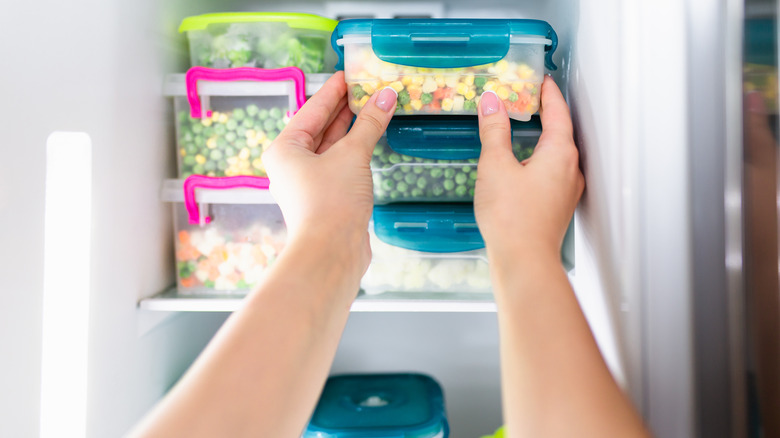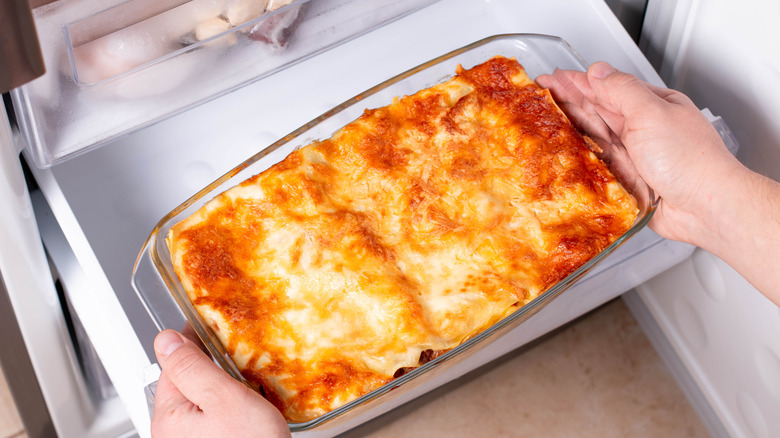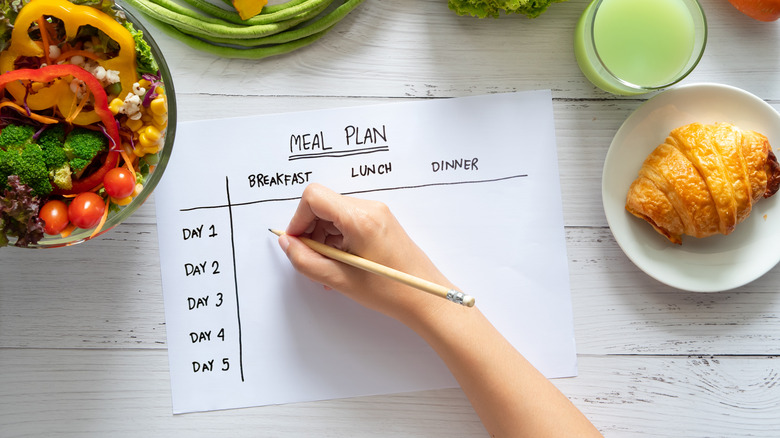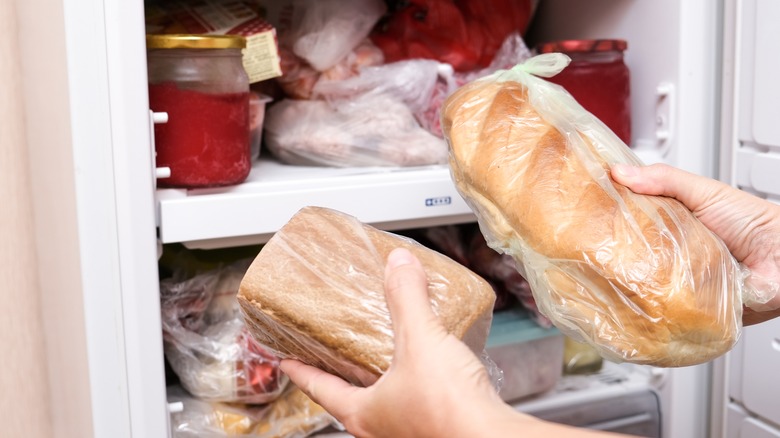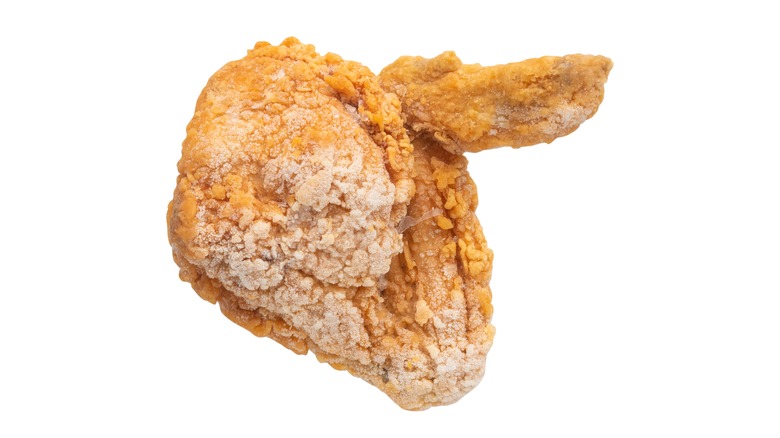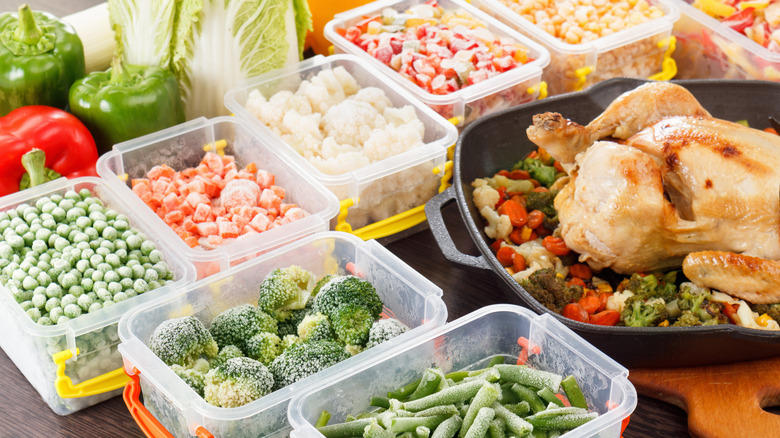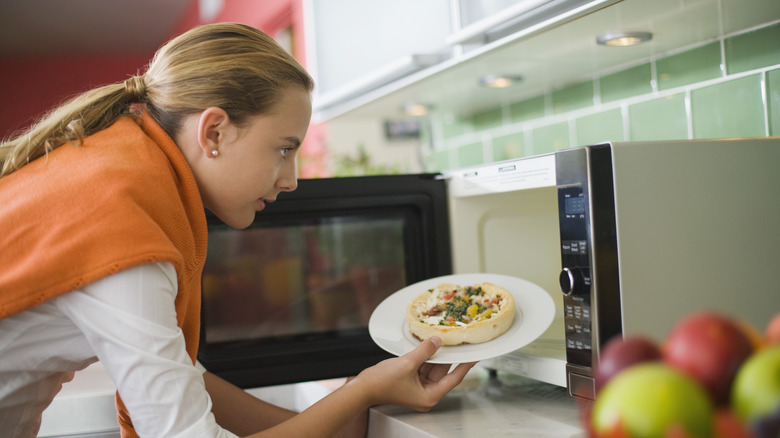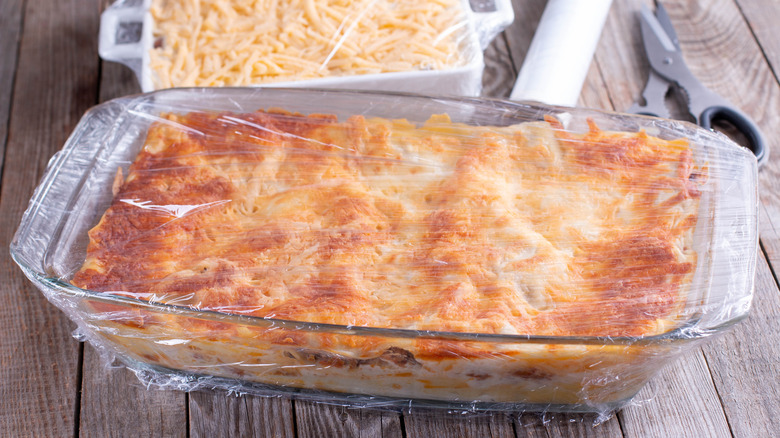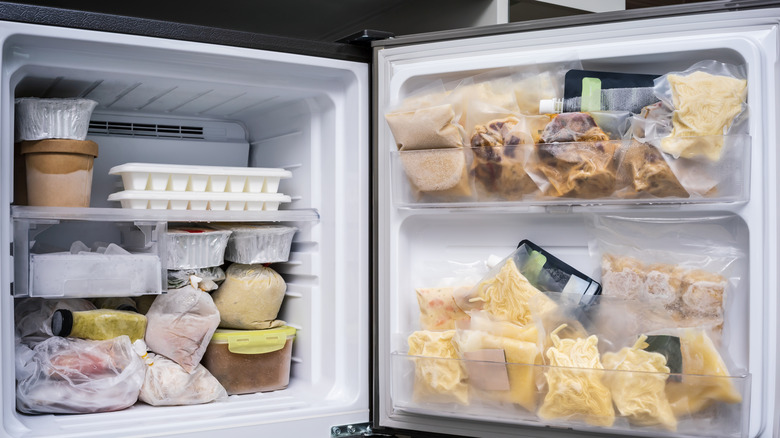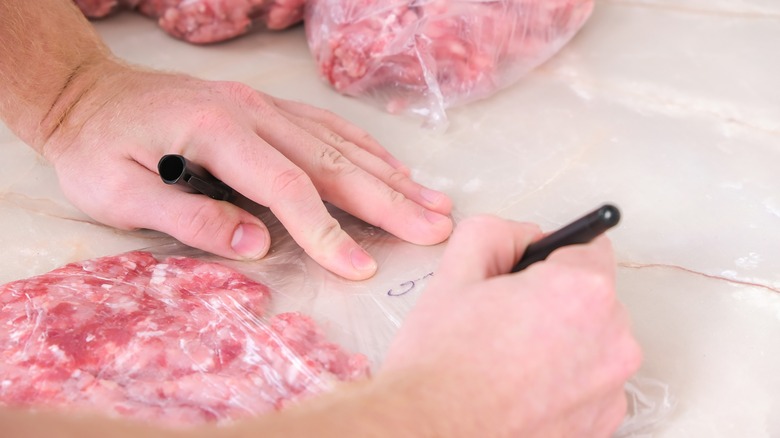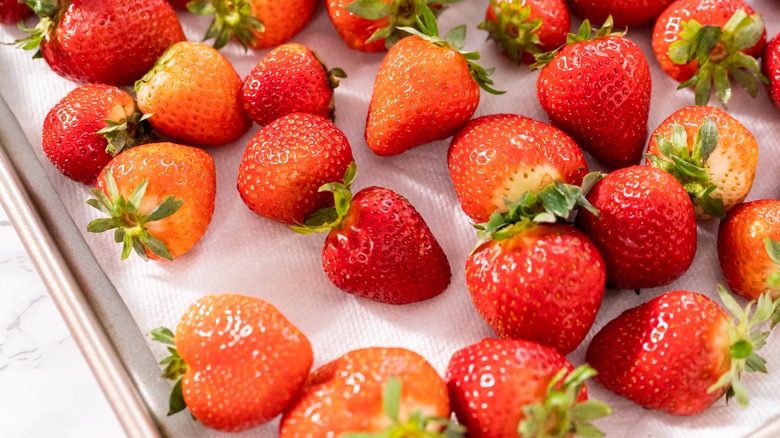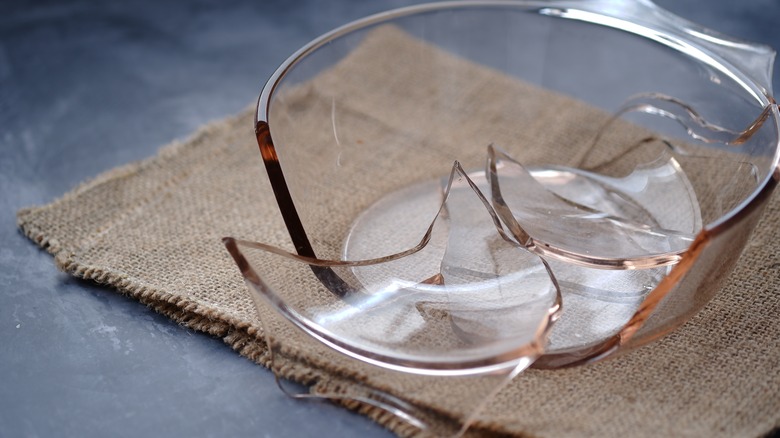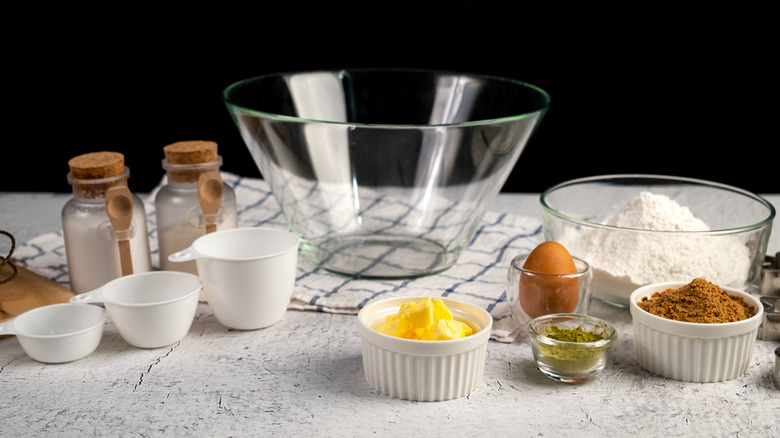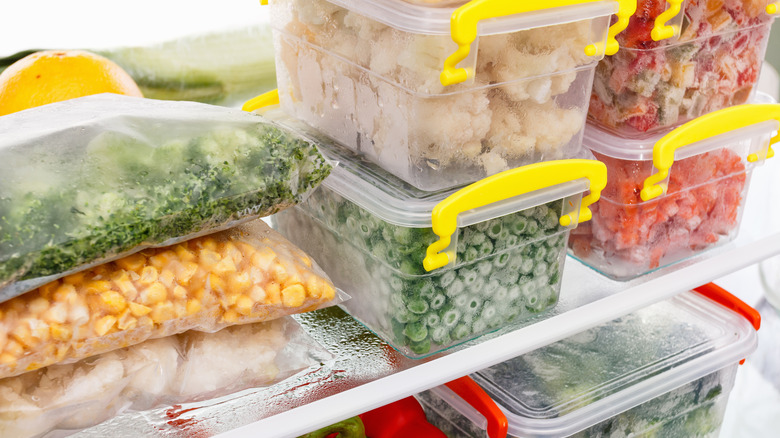14 Mistakes Everyone Makes When Prepping Freezer Meals
It's hard to top the convenience of coming home after a long day and being able to grab a ready-made meal out of the freezer to pop in the oven or microwave to reheat. By skipping the task of making dinner every single night, you can reclaim hours of your free time each week. Do the same thing for work and you can save both time and money by avoiding takeout. However, a lot of the frozen meals you find in stores are loaded with salt or generally not all that nutritious or balanced.
Prepping your own freezer meals is a tried and true method for making healthier versions of your favorite weekly meals while still getting all the perks of a pre-made frozen dish. If you're just starting out or have tried and failed to stick to the habit in the past, here are the most common mistakes you should avoid to make sure prepping freezer meals is as simple and convenient as the life-hack gurus claim.
1. Not freezing meals in the right portions
When you make a big batch of lasagna to eat for dinner over three nights, be sure to divide it into three portions before freezing. If you don't, you'll need to reheat the entire pan on the first night even though you're only eating a fraction of it.
While the U.S. Department of Agriculture (USDA) says repeatedly reheating food is safe as long as it reaches an internal temperature of at least 165 degrees Fahrenheit each time, it's still not recommended. Reheating leftovers more than once can have a negative impact on the flavor and texture of the dish — and not in a good way. In some cases, it can even degrade the nutritional content. Dividing freezer meals into portions to reheat only what you plan to eat is an easy way to preserve the flavor, consistency, and health benefits of your meal.
At the other end of the spectrum, there are the folks who get carried away with portioning freezer meals. When you're prepping for a family of four, for example, don't divide a lasagna into individual servings. Just portion it according to the number of days you plan to eat it and slice it into four servings once you reheat it. If you divide every freezer meal into single servings, you'll run out of containers — and freezer space — quickly. You'll also end up with cluttered shelves that are hard to navigate.
2. Not creating a coordinated meal plan and shopping list first
The first step of freezer meal prepping is making a meal plan for the week. But when you're just starting out, it's easy to get lost in the planning. Some folks try to make a unique breakfast, lunch, and dinner for each day of the week. Then, they end up with a grocery list the size of a CVS receipt filled with ingredients they rarely use. This is a recipe for food waste and will quickly turn meal prepping into an overwhelming task.
Instead, pick just two or three meals for each category so that you're cooking larger batches of fewer recipes. For breakfast, you might even get away with just one meal for the whole week. Then, create a grocery list that specifies exactly how much of each ingredient you need to make your menu.
Most importantly, pick recipes with lots of overlapping ingredients. If you know you want to make fish tacos this week, find other fish recipes to add to the menu. That way, you can potentially save money on a bulk pack of fish. If you know you're making a pasta dish that calls for a few leaves of fresh basil but your grocery store only sells it by the bunch, find other recipes to use up the rest. Meanwhile, if the planning stage has stumped you, try using a meal-planning app to make it easier.
3. Freezing every part of your meal
While a lot of freezer meals are basically just frozen leftovers, prepping doesn't always mean cooking every recipe to the final stage and then freezing it. For starters, not all ingredients in your dish should go in the freezer. Cream-based elements, such as a creamy garlic sauce served on chicken or a lime crema drizzled on tacos, won't freeze well. Cream is basically an emulsion of fat and water, so freezing it causes the water molecules to crystalize and expand which can end up breaking fat molecules. When the cream thaws again, those broken fat molecules become pools of oil and separate from the water.
Instead of freezing your creamy garlic chicken, you could cook the chicken and any other freezable sides in the dish. Then, keep your garlic cream sauce stored in the fridge and simply add it as you're reheating the chicken. When planning your menu, make a note of any components of the dish that might not freeze well and store them appropriately.
4. Freezing meals that don't freeze or thaw well
Just as certain ingredients don't freeze well, some dishes don't work as freezer meals. Salads and slaws, for example, should never go in the freezer. Freezing raw veggies is fine if you're planning to cook them after. But they will become limp and watery as they thaw, and you probably have no interest in eating a salad with those qualities.
For the same reason, most fried foods, like fried chicken, aren't great candidates for freezing. As the water content transforms from ice crystals back to water, the crispy coating will become soggy. If you put fried food straight in the oven rather than waiting for it to thaw, you can prevent this outcome. But for larger pieces, like fried chicken or fish fillets, it can be challenging to cook them fast enough to prevent sogginess while ensuring they are cooked all the way through to the center.
5. Assembling ingredients that have different cook or thaw times
Even if you have made sure that every element of your dish can be frozen, you might end up with an unpleasant result if you combine ingredients that have different thawing requirements or cook times. For example, if you made a roast chicken with a medley of veggies all marinated in a delicious lemon garlic sauce, you might be tempted to store everything together because you'll be serving it together.
However, doing so will cause the food to freeze as a unit, making it tough to reheat. Chicken needs to defrost before going in the oven to ensure it cooks all the way through. Meanwhile, veggies shouldn't be left to thaw because they'll become soggy. Instead, they need to go straight from the freezer to the oven so the moisture evaporates before it has a chance to ruin the texture. In general, store your veggies, sides, and mains separately so that you can reheat each one accordingly to best preserve its flavor and texture.
6. Freezing new recipes you've never eaten before
The you that made that spinach quiche to incorporate more spinach into your diet is not the same you who has to eat it a few days later on your lunch break. Freezer prep is best done with meals you know without a doubt you will want to eat again. And you can only know with certainty if it's something you've eaten before and enjoyed.
Instead of sticking a meal you're making for the first time straight in the freezer, test it out by eating it the same night you cook it. If you like it, you can add it to your freezer meal rotation. If you don't, this gives you a chance to either tweak the recipe to your taste or scratch it off your list before you batch-cook a week's worth of lunches you won't want to eat.
If you are worried about getting tired of eating the same few dishes all week, every week, you can designate one night per week as your day to cook something new. Make a single portion of the recipe you want to try for dinner that night. If it's a success, you can make it again for a future week's menu. If not, you won't have to deal with leftovers.
7. Not completely cooling cooked meals before freezing
While it might not seem like a big deal, it's actually dangerous to put warm food directly into the freezer. The heat from the dish can raise the overall temperature in the freezer high enough to start defrosting surrounding items and place them in what the USDA calls the "danger zone." In turn, bacteria have a chance to multiply before the temperature drops again, increasing the risk of spoilage and contamination.
In addition to safety issues, a fluctuation in temperature can also increase the risk of foods developing freezer burn. Those large patches of spiky ice caked onto frozen foods happen when the water content in foods freezes and thaws repeatedly, allowing the ice crystals that form to expand more each time they re-freeze. Those larger ice crystals can break apart food molecules as they expand, ruining the texture and flavor. By the time you're defrosting it, the excess ice melt will make it even more unpalatable and turn the dish into a water-logged mess. To keep your freezer meals as safe and tasty as possible, wait until the dish cools down to room temperature before storing it.
8. Not purging the freezer of uneaten meals
If you over-prep or end up bored with a dish before you get through the large batch you cooked, it's easy to find yourself with a few stray frozen burritos or forgotten smoothie mixes. Before you cook your next batch of freezer meals, make a habit of looking through the freezer and clearing out any older meals that are past their prime. FoodSafety.gov. reports that all food can be frozen "indefinitely" as long as it is continuously kept at 0 degrees Fahrenheit. But even then, the flavor, texture, and color tend to deteriorate within a few months.
Most prepared meals can be stored in the freezer for up to six months without significantly degrading flavor and texture. For uncooked freezer meals, the time varies based on which ingredients are involved. That's another reason why you want to avoid freezing all the ingredients of a meal together in one container. Depending on the type of meat, the cut, and how it is packaged, storage time can vary widely. The same goes for other raw and cooked ingredients you might be using in your meal prep.
9. Not labeling your freezer meals
For an easier time cleaning out your freezer or to avoid forgetting to eat a frozen meal within the recommended time frame, you should always label every container. At a minimum, the label should include the date you put the meal in the freezer so that you know how long each container has been stored and what you should reach for first.
A more detailed label can make your system even more efficient. Include the eat-by date based on the Department of Health's frozen storage recommendations so you don't have to do the math to figure out how much longer a meal can stay in the freezer when you're looking for what to eat. Also, write the name of the dish to avoid guessing the contents later on. While you're at it, include reheating instructions so you don't have to dig up the original recipe. Extra guidelines will also make it easier for other members of the family to get dinner ready.
10. Not pre-freezing ingredients for better storage
Pre-freezing certain foods isn't necessary from a safety standpoint, but it can make a huge difference in how well your freezer is organized. Not to mention, it will be extra easy to defrost and reheat your meals at a later date. When making a fruit mix to use in smoothies, for example, some folks just throw fresh fruit pieces into a bag and stick it in the freezer. When it's time to actually make a smoothie, the pieces will have frozen together into a giant clump that isn't going to break down easily in a blender.
Instead, pre-freeze the fruit by placing the pieces in a single layer on a baking sheet and popping it in the freezer. Once frozen, you can toss them into bags and they won't form a giant mass. It'll be both easier to stack the bags in the freezer and simpler to blend your smoothies in the morning. Similarly, you can pre-freeze soups or stews in bags by laying them horizontally so that they freeze into a thin, flat shape that's easier to stack.
Another idea is to fill a muffin tin with raw scrambled eggs mixed with diced veggies as single-serving omelets. Once frozen, toss the discs into a bag and throw the muffin tin in the dishwasher. You can do the same with pancake batter in an ice cube tray. Hacks like these allow you to pack more into your freezer without sacrificing space.
11. Putting frozen glass or ceramic straight into the oven
Just as you don't want to put a hot casserole in the freezer, you should avoid putting frozen casseroles straight into a hot oven. In this case, the sudden, dramatic temperature change can cause glass or ceramic to crack or even explode. Known as thermal stress, this kind of breakage happens because heat causes materials like glass or ceramic to expand, while cold causes them to contract.
When exposed to extreme temperature differences, you end up with some parts of the dish becoming hot while others are still frozen. The combination of expansion and contraction causes the dish to literally rip itself apart. Bakeware that is labeled oven-safe and freezer-safe is more resilient to this thermal stress but none is fully immune. It's better to let your frozen dish sit out on the counter while you wait for the oven to preheat.
12. Trying to prep everything on Sunday
Unless you're planning to eat the same three meals all week long, it's usually not realistic to cook a full week of breakfasts, lunches, and dinners in a single day. Instead, try one of two options. The first is to have two meal prep days per week. Sunday can be your big prep day when you prep lunches for the week and maybe one dinner. If you're also making breakfast, you can squeeze it in on this day if you pick a quick and easy recipe.
The second prep day can be for building up a stock of longer-term "as needed" freezer meals. Cook one of your family's favorite go-to meals for dinner that night but make double or triple the recipe to have on hand for the next six months. Plan to eat one or two of these meals per week to cut down on the number of new meals you have to prep each Sunday.
Your second option is to get the whole family involved. Cooking a week's worth of meals for a whole family might not be realistic for one person. But if you've got two or three people in the kitchen helping with the prep work, cooking, and clean up, it's definitely possible.
13. Not practicing mise en place for meal prep
Even a realistic Sunday meal prep plan can become unwieldy if you don't tackle it right. If you're constantly jumping between dicing onions, stirring the contents of a pot, and mixing batter, you'll get overwhelmed and are liable to mess up a recipe.
To avoid this, take a page from a chef's playbook by adopting what's called "mise en place," or "everything in its place." Place all of the ingredients and equipment needed for the recipe on the counter and do all the basic prep work before you start cooking. Dice what needs to be diced. Chop what needs to be chopped. Measure out each of your ingredients so you can just dump them in as needed rather than measure as you go.
Professional kitchens use this strategy to make it easier to simultaneously prepare multiple dishes as diners order them. But it's just as useful in this context since prepping freezer meals also involves juggling a number of steps at once. When prepping various meals, set up your mise en place for each recipe first. Keep ingredients separate so that as you're cooking, you just have to grab the right ingredient from the right pile at the right time, instead of scrambling to chop, blend, or measure as you go.
14. Not choosing the right container
While it might not seem like it, not all containers are safe to put in the freezer. Glass that hasn't been tempered, for example, can shatter from thermal stress in a freezer just as it would in an oven. Meanwhile, plastic bags that aren't labeled as freezer safe are typically not thick enough to avoid tearing or puncturing as the foods they hold develop sharp ice crystals during freezing. Likewise, some Tupperware containers are too thin and flimsy for regular use in the freezer.
The meal prep containers you use will also influence your freezer's organization and ease of navigation. While it might seem easier to pour soups or other liquids into Tupperware, bags can actually be a more economical choice as you can remove the excess air at the top before closing. That's less wasted air space taking up room in your freezer. Meanwhile, baked goods and delicate items are better kept in a container with solid walls that can protect them from getting crushed when stacked.
The more you make a habit of freezer meal prepping, the faster your freezer will fill up. It's important to make sure you're storing food in a way that avoids wasted space and allows you to easily find what you need.
